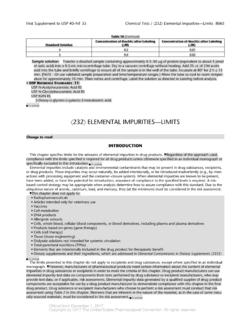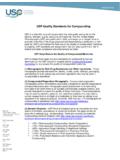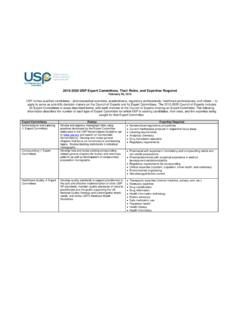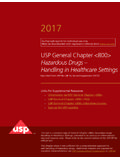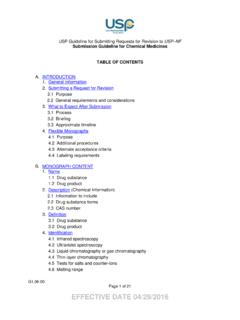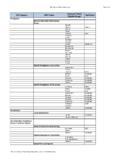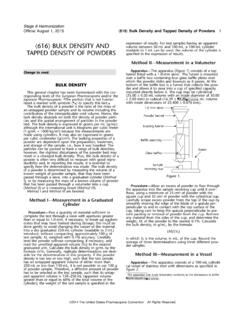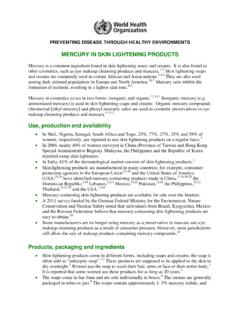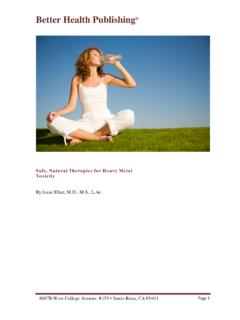Transcription of Add the following: ELEMENTAL IMPURITIES— Table …
1 Revision BulletinOfficial February 1, 2013 232 ELEMENTAL Impurities Limits1of interest for three routes of administration: oral, paren-Add the following: teral, and inhalational. These limits are based on chronicexposure. The other two routes of administration, mucosaland topical, are considered to be the same as oral for the 232 ELEMENTAL IMPURITIES purpose of this standard, and the PDEs described in Table 1would apply to these products. [NOTE The routes of ad-LIMITS ministration of drug products are defined in general chap-ter Pharmaceutical Dosage Forms 1151 .] Official February 1, 2013 (RB 1-Feb-2013)DRUG PRODUCTSINTRODUCTIONThe limits described in the second through fourth col-umns of Table 1 are the base daily dose PDEs of the ele-This general chapter specifies limits for the amounts ofmental impurities of interest for a drug product taken byelemental impurities in drug products.
2 ELEMENTAL impuritiesthe patient according to indicated routes of catalysts and environmental contaminants that mayParenterals with an intended maximum dose of greaterbe present in drug substances, excipients, or drug prod-than 10mL and not more than 100mL must use the Sum-ucts. These impurities may occur naturally, be added inten-mation Option described , or be introduced inadvertently ( , by interac-tions with processing equipment). When elementalLarge-Volume Parenteralsimpurities are known to be present, have been added, orhave the potential for introduction, assurance of compli-When the daily dose of an injection is greater thanance to the specified levels is required. A risk-based control100mL (large-volume parenteral (LVP)), the amount of ele-strategy may be appropriate when analysts determine howmental impurities present in the drug product must beto assure compliance with this standard.
3 Due to the ubiqui-controlled through the individual components used to pro-tous nature of As, Cd, Pb, and Hg, they (at the minimum)duce the product. The amounts of ELEMENTAL impuritiesmust be considered in the risk-based control strategy. Re-present in each component used in an LVP are less thangardless of the approach used, compliance with the limitsthe values included in the fifth column of Table is required for all drug limits presented in this chapter do not apply to ex-cipients and drug substances, except where specified in thisOptions for Demonstrating Compliancechapter or in the individual monographs. However, elemen-tal impurity levels present in drug substances and excipi-ents must be known and limits indicated in this chapter are not required forDRUG PRODUCT ANALYSIS OPTION articles intended only for veterinary use and conventionalvaccines. Dietary supplements and their ingredients are ad-The results obtained from the analysis of a typical dosagedressed in ELEMENTAL Contaminants in Dietary Supplementsunit, scaled to a maximum daily dose, are compared to the 2232.
4 Daily Dose Dose PDE measured value (mg/g) maximum dailySPECIATION dose (g/day)The determination of the oxidation state, organic com-The measured amount of each impurity is NMT the Dailyplex, or combination is termed speciation. Each of the ele-Dose PDE, unless otherwise stated in the individualmental impurities has the potential to be present in oxidation or complexation states. However, arsenic andmercury are of particular concern because of the differingtoxicities of their inorganic and complexed organic OPTIONThe arsenic limits are based on the inorganic (most toxic)form. Arsenic can be measured using a total-arsenic proce-Separately add the amounts of each ELEMENTAL impuritydure under the assumption that all arsenic contained in the(in mg/g) present in each of the components of the drugmaterial under test is in the inorganic form. Where the limitproduct using the following equation:is exceeded using a total arsenic procedure, it may be pos-Daily Dose PDE [SM1(CM WM)] DDsible to show via a procedure that quantifies the differentforms that the inorganic form meets the = each ingredient used to manufacture a dosage unitThe mercury limits are based upon the inorganic (2+) oxi-CM = element concentration in component (drug sub-dation state.)
5 The methyl mercury form (most toxic) is rarelystance or excipient) (mg/g)an issue for pharmaceuticals. Thus, the limit was establishedWM = weight of component in a dosage unit (g/dosageassuming the most common (mercuric) inorganic )Limits for articles that have the potential to contain methylDD = number of units in the maximum daily dose (unit/mercury ( , materials derived from fish) are to be pro-day)vided in the result of the summation of each impurity is NMT theDaily Dose PDE, unless otherwise stated in the individualROUTES OF EXPOSURE monograph. Before products can be evaluated using thisoption, the manufacturer must validate that additional ele-The toxicity of an ELEMENTAL impurity is related to its ex-mental impurities cannot be inadvertently added throughtent of exposure (bioavailability). The extent of exposurethe manufacturing been determined for each of the ELEMENTAL impurities 2013 The United States Pharmacopeial ConventionAll Rights Bulletin2 232 ELEMENTAL Impurities LimitsOfficial February 1, 2013 The values provided in Table 2 represent concentrationDRUG SUBSTANCE AND EXCIPIENTS limits for components (drug substances and excipients) ofdrug products dosed at a maximum daily dose of 10 g/The presence of ELEMENTAL impurities in drug substancesday.
6 These values serve as default concentration limits toand excipients must be controlled and, where present, re-aid discussions between drug product manufacturers andported. The acceptable levels for these impurities dependthe suppliers of the components of their drug the material s ultimate use. Therefore, drug product[NOTE Individual components may need to be limited atmanufacturers must determine the acceptable level of ele-levels different from those in the Table depending on mon-mental impurities in the drug substances and excipientsograph-specific mitigating factors.]used to produce their products. Table 1. ELEMENTAL Impurities for Drug ProductsOralParenteralInhalationalDailyD ailyDailyLVPDoseDoseDoseComponentPDEaPDE PDEL imitElement(mg/day)(mg/day)(mg/day)(mg/g ) c c25 cMolybdenum10010 10 (ERR 1-Oct-2012) 100 (ERR 1-Feb-2013) 10 (ERR 1-Feb-2013)aPDE = Permissible daily exposure based on a 50-kg Speciation a safety 2.
7 Default Concentration Limits for Drug Substances and ExcipientsConcentration LimitsConcentration LimitsConcentration Limits(mg/g) for(mg/g) for(mg/g) forOral DrugParenteralInhalationalProducts with aDrug Products with aDrug Products with aMaximumMaximumMaximumDaily DoseDaily DoseDaily DoseElementof 10 g/dayof 10 g/dayof 10 10 (ERR 1-Oct-2012) (ERR 1-Oct-2012) (ERR 1-Oct-2012)Chromium a (ERR 1-Oct-2012) 10 (ERR 1-Oct-2012) (ERR 1-Oct-2012) (ERR 1-Oct-2012)Copper10010 10 (ERR 1-Feb-2013)aNot a safety concern. 2013 The United States Pharmacopeial ConventionAll Rights BulletinOfficial February 1, 2013 232 ELEMENTAL Impurities Limits3demonstrate compliance, proceed as directed in generalANALYTICAL TESTING chapter ELEMENTAL Impurities Procedures 233 , and mini-mally include As, Cd, Pb, (ERR 1-Oct-2012) and Hg in the Tar-If, by validated processes and supply-chain control, man-get Element evaluation.
8 (RB 1-Feb-2013)ufacturers can demonstrate the absence of impurities, thenfurther testing is not needed. When testing is done to 2013 The United States Pharmacopeial ConventionAll Rights Reserved.
